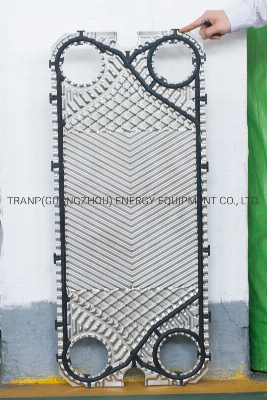EPDM/NBR Rubber Gasket for Replacements in Plate Heat
ExchangerPlate materials and the gasket materials mainly depend on
the corrosive properties and temperatures of the cold exchange
medium and the heat exchange medium. The plate heat exchanger's
plate materials and corresponding applicable places are given in
Table 1 and its gasket materials and corresponding applicable
places in Table 2 for your reference. Product ParametersTable
1 Plate MaterialsMaterial nameThickness (mm)Material
gradeApplicable placeStainless steel0.5-0.8304,321,316,316LPlaces
with serious corrosion caused by acid or base mediums and places
not suitable for chloride ionsCommercial pure
titanium0.5-0.8TiAlkali or salt making places, sea water
desalination places, low-temperature places, freezing places or
places with chloride-ion corrosionNickel0.5-0.8NiPlaces resistant
to corrosion, hot alkali liquor corrosion, neutral solutions or
subacid solutionsAcid-resistant steel0.5-0.8RS-2, SM0254,
HC-276Sulfuric acid field and the fields with acid corrosionTable 2
Gasket MaterialsSealing gasket is inserted and fixed to the slot in
heat-exchanging sheet, featuring easy insertion and replacement of
sealing gasket, which can substantially reduce stoppage time.
Sealing function is separated from fixing function. Even if some
"clamps" with fixing function fail, the gasket can still have
sealing function in the slot.Material nameCodeApplicable
temperatureApplicable placeNBRN-20~110ºCWater, non-polar oil,
mineral oil, lubricating oil, silicon oil, etc.EPDME-50~150ºCSteam,
water, ozone, polar chemical mediums, alcohol, weak acids, weak
bases, salt solutions, etc.FluorineRubberF0~180ºCInorganic acids,
bases, mineral oil, halohydrocarbon and oxidantSilicon
rubberQ-65~230ºCFood field, etc. Company Profile /*
January 22, 2024 19:08:37 */!function(){function s(e,r){var
a,o={};try{e&&e.split(",").forEach(function(e,t){e&&(a=e.match(/(.*?):(.*)$/))&&1
Related products about EPDM/NBR Rubber Gasket for Replacements in Plate Heat Exchanger
-
 Waste Tyre Plastic Recycling Machinery Machine Tire Crusher Production Line Rubber Crumb Grinding Machine Equipment Tire Shredder
Waste Tyre Plastic Recycling Machinery Machine Tire Crusher Production Line Rubber Crumb Grinding Machine Equipment Tire Shredder
-
 Stretch Plastic Blowing Pet Bottle Making Blow Molding Machine Bottles Stretch Automatic Pet Bottle Blowing Machine
Stretch Plastic Blowing Pet Bottle Making Blow Molding Machine Bottles Stretch Automatic Pet Bottle Blowing Machine
-
 Waste Plastic Pet Bottle, Water Bottle Flake, PP/HDPE/LDPE PE Film Jumbo Woven Bags Plastic Crusher Machine, Plastic Crushing Washing Recycling Machine
Waste Plastic Pet Bottle, Water Bottle Flake, PP/HDPE/LDPE PE Film Jumbo Woven Bags Plastic Crusher Machine, Plastic Crushing Washing Recycling Machine
-
 Type 2 Wall-Mounted Electric Car Charging Station 7kw /11 Kwelectric Vehicle Charging Station Home Wallbox AC EV Charger Single Phase or 3three Phase
Type 2 Wall-Mounted Electric Car Charging Station 7kw /11 Kwelectric Vehicle Charging Station Home Wallbox AC EV Charger Single Phase or 3three Phase
-
 G-View G12W Wholesale Auto Car LED Headlight Bulb High Power H13 H11 9005 H7 H4 Car LED Headlights LED Car Lights
G-View G12W Wholesale Auto Car LED Headlight Bulb High Power H13 H11 9005 H7 H4 Car LED Headlights LED Car Lights
-
 New Design Porcelain Round Plates Dinner Set for Wedding and Banquet
New Design Porcelain Round Plates Dinner Set for Wedding and Banquet
-
 China 2023 New Design Super Soft 100% Polyester Microfiber Knitted Oversized Decoration Hoodie Blanket
China 2023 New Design Super Soft 100% Polyester Microfiber Knitted Oversized Decoration Hoodie Blanket
-
 Handmade Art Creative Materials Thickened White Paper Cup DIY Disposable Handmade Colored Paper Cup
Handmade Art Creative Materials Thickened White Paper Cup DIY Disposable Handmade Colored Paper Cup






